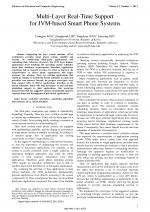| 3/2013 - 1 | View TOC | « Previous Article | Next Article » |
Multi-Layer Real-Time Support for JVM-based Smart Phone SystemsWOO, Y. |
| Extra paper information in |
| Click to see author's profile in |
| Download PDF |
Author keywords
real-time schedulers, scheduling algorithm, smart phones, Java, virtual machines
References keywords
time(17), real(16), presented(11), systems(8), embedded(7), linux(6), operating(5), mobile(4), kernel(4), java(4)
Blue keywords are present in both the references section and the paper title.
About this article
Date of Publication: 2013-08-31
Volume 13, Issue 3, Year 2013, On page(s): 3 - 10
ISSN: 1582-7445, e-ISSN: 1844-7600
Digital Object Identifier: 10.4316/AECE.2013.03001
Web of Science Accession Number: 000326321600001
SCOPUS ID: 84884936498
Abstract
Employing the Java virtual machine (JVM) architecture provides smart phone systems stability and security by sandboxing third-party applications and controlling their behavior. However, the JVM layer hinders applications from notifying the operating system scheduler about their timeliness requirements; therefore, applications sometimes fail to respond on time. In order to improve the responsiveness of smart phone applications, this paper proposes two schemes. First, for existing applications that cannot be rebuilt, we modify the kernel scheduler to value task priorities over fairness. Second, we propose cross-layer real-time support APIs to deliver applications' priorities to the kernel scheduler, which will help developers to add real-time scheduling support to their applications. Our prototype demonstrates that the suggested schemes dramatically improve response times and throughputs of prioritized applications. |
| References | | | Cited By |
Web of Science® Times Cited: 0
View record in Web of Science® [View]
View Related Records® [View]
Updated today
SCOPUS® Times Cited: 0
View record in SCOPUS® [Free preview]
There are no citing papers in the CrossRef Cited-by Linking system.
Disclaimer: All information displayed above was retrieved by using remote connections to respective databases. For the best user experience, we update all data by using background processes, and use caches in order to reduce the load on the servers we retrieve the information from. As we have no control on the availability of the database servers and sometimes the Internet connectivity may be affected, we do not guarantee the information is correct or complete. For the most accurate data, please always consult the database sites directly. Some external links require authentication or an institutional subscription.
Web of Science® is a registered trademark of Clarivate Analytics, Scopus® is a registered trademark of Elsevier B.V., other product names, company names, brand names, trademarks and logos are the property of their respective owners.
Faculty of Electrical Engineering and Computer Science
Stefan cel Mare University of Suceava, Romania
All rights reserved: Advances in Electrical and Computer Engineering is a registered trademark of the Stefan cel Mare University of Suceava. No part of this publication may be reproduced, stored in a retrieval system, photocopied, recorded or archived, without the written permission from the Editor. When authors submit their papers for publication, they agree that the copyright for their article be transferred to the Faculty of Electrical Engineering and Computer Science, Stefan cel Mare University of Suceava, Romania, if and only if the articles are accepted for publication. The copyright covers the exclusive rights to reproduce and distribute the article, including reprints and translations.
Permission for other use: The copyright owner's consent does not extend to copying for general distribution, for promotion, for creating new works, or for resale. Specific written permission must be obtained from the Editor for such copying. Direct linking to files hosted on this website is strictly prohibited.
Disclaimer: Whilst every effort is made by the publishers and editorial board to see that no inaccurate or misleading data, opinions or statements appear in this journal, they wish to make it clear that all information and opinions formulated in the articles, as well as linguistic accuracy, are the sole responsibility of the author.



